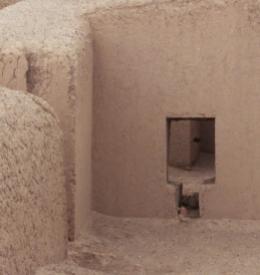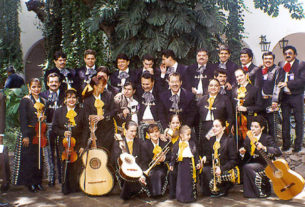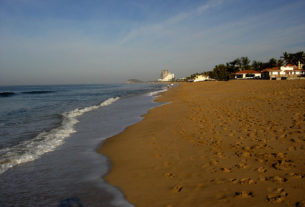Paquimé, sometimes called Casas Grandes, is probably the most important ruin in Northern Mexico. It was the center of trade and activity for a large area during it’s peak. The period of maximum construction is variously dated 1060 to 1340, or 1250 to 1340. Paquimé was burned around 1340. The ruins are near the modern town of Nuevo Casas Grandes, Chihuahua.
In many respects, Paquimé was a kind of hybrid or link between the cultures of Mesoamerica, in the center of Mexico, and the pueblo culture of the Anasazi, from the four corners area of Colorado, New Mexico, Arizona, and Utah.
From the Pueblo culture, the similarities include the T-shaped doors, as well as the stone disks under the ceiling support columns. One interesting fact is that Chaco Canyon, Aztec and Paquimé are all aligned very accurately, relative to each other, on north-south axis. That is, they share the same longitude, with an error of a couple of miles, over a distance of more than 400 miles! The heights of the culture in the three places were sequential, with Chaco first, Aztec next, and Paquimé last.

At their peak, each of these communities was by far the largest community for hundreds of miles. The archeologist Stephen Lekson builds on the similarities between the three sites to argue that the north-south alignment was not a coincidence, but had a ceremonial significance for the ruling elite, who moved from one site to the next.
From Mesoamerica, Paquimé had ballcourts, like the Aztecs and the Maya. The ballcourts were, however, relatively small compared to those found at Teotihuacán or Chichén-Itzá, or other major sites.
Paquimé, unlike Chaco or Aztec, raised macaws from the tropics, while Chaco and Aztec used macaws feathers in their ceremonies. The small adobe structures were used for raising macaws and/or turkeys.
Water was a major issue in the arid climate of the region, and Paquime had water tanks and canals to deliver water to the dwelling areas.
The houses were built of mud cast in place with forms, rather than adobe bricks. The height of the buildings was at least four stories.

In addition to pueblo style buildings, there are ceremonial mounds of various shapes, including one shaped like a serpent.
The museum is excellent, one of the best that we have seen in Mexico, with signage and explanation in English and Spanish.
There are other attractions in the area, most notably the town of Mata Ortiz, famous for pottery, with many of the designs based on pots excavated at Paquimé. The ruin of the hacienda of San Diego is on the road to Mata Ortiz; it is occupied by a family, but their daughter will give tours in English for a donation.
 The Hacienda “El Refugio”, close to Casas Grandes, has been completely restored by a family, but the guardian let us walk through for a tip. Further south is the town of Madera, near the ruins of Cuarenta Casas. Even further south is the waterfall of Basaseachic, and the famous Copper Canyon.
The Hacienda “El Refugio”, close to Casas Grandes, has been completely restored by a family, but the guardian let us walk through for a tip. Further south is the town of Madera, near the ruins of Cuarenta Casas. Even further south is the waterfall of Basaseachic, and the famous Copper Canyon.
The town of Nuevo Casas Grandes is the logical base for exploring Paquimé and Mata Ortiz, with hotels, restaurants, a campground, banks, hospitals, and anything else that you are likely to need. It is a clean and modern town, serving the surrounding agricultural areas. It is three or four hours south of the border, with the closest border crossing being Columbus, New Mexico, famous for Pancho Villa’s attack on the town.
Paquimé is a very important ruin, with an excellent museum. If you are an archeology aficionado, or are in the area to go to Mata Ortiz, or for any other reason, it is well worth a visit.
Bibliography:
- The Chaco Meridian, by Stephen Lekson, 1999, Altamira Press.
- Guia Oficial, Paquimé y Las Cuarenta Casas, Arturo Guevara Sanchez, 1991, Instituto Nacional de Antropologia e Historia


